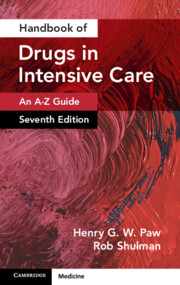Book contents
- Handbook of Drugs in Intensive Care
- Handbook of Drugs in Intensive Care
- Copyright page
- Dedication
- Contents
- Introduction
- How to Use This Book
- Common Abbreviations
- Acknowledgements
- Drugs: An A–Z Guide
- Chapter A
- Chapter B
- Chapter C
- Chapter D
- Chapter E
- Chapter F
- Chapter G
- Chapter H
- Chapter I
- Chapter K
- Chapter L
- Chapter M
- Chapter N
- Chapter O
- Chapter P
- Chapter Q
- Chapter R
- Chapter S
- Chapter T
- Chapter V
- Chapter Z
- Short Notes
- Appendices
- Drug Index
Chapter P
from Drugs: An A–Z Guide
- Handbook of Drugs in Intensive Care
- Handbook of Drugs in Intensive Care
- Copyright page
- Dedication
- Contents
- Introduction
- How to Use This Book
- Common Abbreviations
- Acknowledgements
- Drugs: An A–Z Guide
- Chapter A
- Chapter B
- Chapter C
- Chapter D
- Chapter E
- Chapter F
- Chapter G
- Chapter H
- Chapter I
- Chapter K
- Chapter L
- Chapter M
- Chapter N
- Chapter O
- Chapter P
- Chapter Q
- Chapter R
- Chapter S
- Chapter T
- Chapter V
- Chapter Z
- Short Notes
- Appendices
- Drug Index
Summary
Wernicke’s encephalopathy can be difficult to diagnose, and the consequences of leaving it untreated can be devastating. Pabrinex is a combination of water-soluble vitamins B and C, which is used parenterally to rapidly treat severe depletion or malabsorption, particularly after alcoholism. As thiamine does not exist as a licensed parenteral product, Pabrinex is widely used to treat and prevent Wernicke’s encephalopathy, and in refeeding syndrome. An alternative approach is to use an unlicensed IV thiamine product.
- Type
- Chapter
- Information
- Handbook of Drugs in Intensive CareAn A-Z Guide, pp. 236 - 264Publisher: Cambridge University PressPrint publication year: 2025

